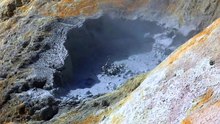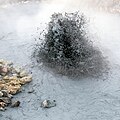Mud pot
A mud pot (also mud bubble , English mud pot ) is a hot spring , resulting in geothermal active areas in low groundwater inflow forms.
functionality
Groundwater feeds the source; much of it evaporates, the rest of the water rises to the surface along with superheated water vapor and volcanic gases at a point where the soil is rich in volcanic ash , clay or other fine particles that mix with water to form mud .
The sludge takes on the form of a viscous suspension that often boils in a bubbling manner due to the steam .
Relationship with the fumaroles
Mud pots are a special form of fumaroles and are signs of low volcanic activity. This can be decreasing, but it can also stand for the opposite, namely for increasing volcanic activity, if a new area with such mud pots is formed or an old, previously dried up area is revived ( cf.e.g. Hveragerði in Iceland) .
The exhalations of simple fumaroles contain lower amounts of water vapor than those of mud pots, so there is no formation of sludge.
Color scheme and composition
The volcanic mud is generally white to gray in color ( sulfur compounds ), sometimes red or pink colored parts appear due to the addition of iron . Sources with such bright colors are also called paint pots. Under certain conditions, the mud can form a volcanic cone, usually no more than one to two meters high.
Examples
Notable examples of mud pots can be found in the geothermally active areas of Yellowstone National Park in the northern United States or in the Lake Mývatn area in Iceland .
Mud volcanoes
The mud volcanoes represent a related geological phenomenon .
photos
A mud pot in the Kraflaggebiet in Iceland
Boiling mud at Námafjall , Iceland
Mud pot on Sakhalin
In the Rincón de la Vieja National Park in Costa Rica
See also
Web links
- Video: Active mud pot on the Gunnuhver, southwest Iceland
- Video: Mud pots in action in the reawakened high temperature area in Hveragerði, Iceland
- Nicole Büchner: Geothermal features: thermal springs, geysers, sintered terraces, fumaroles, mud bubbles. Freiberg Mining Academy and Technical University. WS 2003/04 (PDF; 1.1 MB) ( Memento from June 10, 2007 in the Internet Archive )








